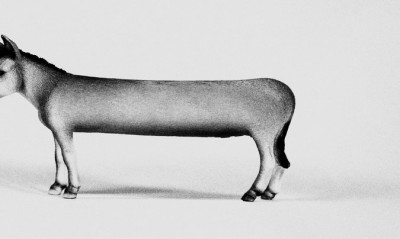The New York Times Scrapes the Bottom to Argue “Democrats Pulled Too Far Left”

The New York Times illustrated Peter Wehner’s piece with a stretched-out donkey. A load of bull would have been more appropriate. (graphic: Matt Chase)
“Have Democrats Pulled Too Far Left?” asks a New York Times op-ed (5/27/15). Because this question isalways answered affirmativelyby corporate media, you don’t even have to note that the author, Peter Wehner, “served in the last three Republican administrations” to know that the answer is going to be yes.
Despite the predictable thesis, however, the column still manages to surprise with its degree of intellectual dishonesty. Wehner’s thesis is that Barack Obama has “moved to the left” compared to “centrist New Democrat” Bill Clinton. But whenever Wehner makes a claim that can be checked—that isn’t simply empty rhetoric, like his assertion that Obama “has often acted as if American strength is a problem”—again and again it turns out to involve some numbers game.
Take Wehner’s claim that while Clinton
endorsed a sentencing policy of “three strikes and you’re out,”…Obama’s former attorney general, Eric H. Holder Jr., criticized what he called “widespread incarceration” and championed the first decrease in the federal prison population in more than three decades.
You’d never know from that that the federal prison population is 48 percent bigger under the “left” Obama than it was when centrist Clinton left office.
“Mr. Clinton lowered the capital-gains tax rate; Mr. Obama has proposed raising it,” Wehner says. Clinton lowered the rate capital gains were taxed at to 20 percent; under Obama it went up—to 20 percent.
“Mr. Clinton cut spending and produced a surplus,” writes Wehner. “Under Mr. Obama, spending and the deficit reached record levels.” From 1993 through 2000, Clinton reduced the US budget imbalance as a proportion of US GDP by 6 percentage points; from 2009 through 2014, Obama reduced it by 7 percentage points.
Wehner adds as “another bellwether” the fact that Hillary Rodham Clinton “is decidedly more liberal than she and her husband once were.” One example of this: “She has remained noncommittal on the Trans-Pacific Partnership, the free-trade agreement that has drawn ire from the left”—but which has been strenuously pushed by Barack Obama, though Wehner does not acknowledge this as evidence of Obama’s centrism.
But perhaps the most deceptive part of Wehner’s op-ed is when he blames Obama’s supposed shift to the left for the failing fortunes of the Democratic Party:
After two enormous losses by Democrats in the 2010 and 2014 midterm elections, Republicans control the Senate and the House of Representatives. There are currently 31 Republican governors compared with 18 for Democrats…. The Obama years have been politically good for Mr. Obama; they have been disastrous for his party.
Surely Wehner remembers that after the first half of Clinton’s first term, Republicans controlled both the House and the Senate for the remainder of his administration—exactly as happened under Obama. There were 30 Democratic governors when Clinton took office, and 19 when he left; there were 29 when Obama took office, and currently there’s 18.
It’s true that Obama has been been bad news for his party—but as FAIR haslong pointed out, that’s true of Clinton as well. An honest appraisal of the administrations of both Clinton and Obama, with their emphasis on deficit-cutting and corporate-friendly trade deals, reveals both Democrats to be establishment centrists—and centrist politics, contrary to what the punditocracy would have you believe, do not have a particularly winning record at the ballot box.
You can send a message to the New York Times at [email protected], or to public editor Margaret Sullivan at [email protected]. Please remember that respectful communication is the most effective.

